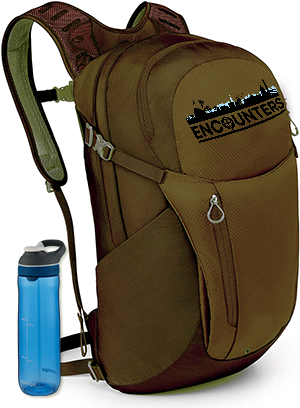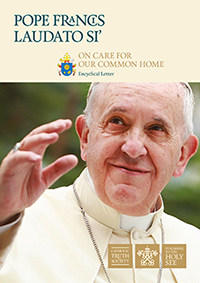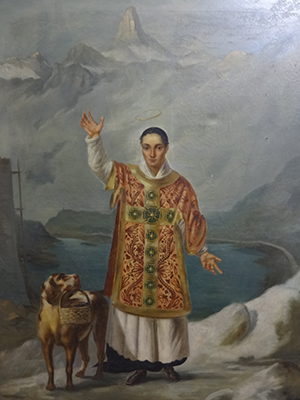Before You Go
1. Plan your journey by viewing the trail website and selecting a starting point. Northern Virginia Regional Park Authority website: https://www.novaparks.com/parks/bull-run-occoquan-trail
2. Remember, don't just hike, retreat! See discussion questions below designed to help you turn this hike into a prayerful retreat for your family or group.
3. Be prepared! Check the weather and be sure to review the suggested packing list.
What to bring on your hike
- Backpack
- Plenty of water
- Proper footwear; sturdy hiking boots recommended
- Basic first-aid kit for minor abrasions caused by falling, scraping against branches/bushes, blisters, etc.
- Insect repellent
- Hat
- Sunscreen as necessary
- Sunglasses
- Mobile phone, GPS device, and/or map. Note that cellular service may not be reliable in all areas of the trail.
- Food/snacks
- Picnic blanket (optional)
- Rosary
- Journal/Pen
Laudato Si
 In 2015, Pope Francis published the Encyclical Letter, Laudato Si' On Care for our Common Home.
In 2015, Pope Francis published the Encyclical Letter, Laudato Si' On Care for our Common Home.
“Laudato Si', mi' Signore” - “Praise be to you, my Lord”. In the words of this beautiful canticle, Saint Francis of Assisi reminds us that our common home is like a sister with whom we share our life and a beautiful mother who opens her arms to embrace us. “Praise be to you, my Lord, through our Sister, Mother Earth, who sustains and governs us, and who produces various fruit with colored flowers and herbs”.
Discussion: In his opening words of Laudato Si, Pope Francis calls the earth “a sister with whom we share our life and a beautiful mother who opens her arms to embrace us.” In what ways is the earth our sister? In what ways is she our mother?
The full text of Laudato Si' may be found online at https://tinyurl.com/o6sowft
(en Español) https://tinyurl.com/ncnkttm
A Hiking Prayer
Lord Jesus, Help me to be straightforward like the sky-seeking redwood tree. May my generosity be like the sap which ascends and nourishes. May my soul be clear like the spring water at its origin. May my will be like the faultless granite.
May You be always throughout my life a constant companion. May the cross which rises at the crossroads be for me like the meeting of a friend. -Amen.
 St. Bernard of Montjoux. - Patron Saint of Hikers | Feast day: May 28
St. Bernard of Montjoux. - Patron Saint of Hikers | Feast day: May 28
St. Bernard of Montjoux, patron saint of hikers, mountain climbers, skiers, snowboarders, backpackers, and the Alps, was born around 1020. It isn't known exactly where he was born but is said he was born in the Chateau de Montjoux near Annecy, then in the County of Savoy, which was part of the Kingdom of Arles in France. He was descendant from a rich and noble Italian family. As a young boy, he was sent to Paris for his education. Once he became of age, his father had arranged an honorable marriage for him, but he refused. Legend says that on the night before his wedding, he threw himself from window in the castle only to be caught by angels who gently lowered him to the ground below, about 40 feet.
He decided he wanted to devote himself to the service of the Church. He studied under the direction of Peter, Archdeacon of Aosta. He was very quickly ordained a preist and disturbed by seeing the old pagan ways continue among the people of the Alps, he devoted himself as a missionary in the mountain villages to aid in their conversion. Considering his virtue and all he had learned, he was later appointed to succeed his teacher and mentor as the Archdeacon of Aosta, giving him charge of the government of the diocese, directly under the Bishop.
He climbed and hiked from village to village for the next 42 years. He preached the Gospel to many effecting numerous conversions and worked many miracles. During this time, he met hundreds of people who had lost loved ones and friends while crossing the snowy mountains. He founded the Congregation of Canons Regular and in the year 1050 opened a monastery and hospice at the highest peak, what is now known as the Great St. Bernard Pass, 8,100 feet above sea level. Monks, with their large dogs assisting them (St. Bernards, named after St. Bernard of Montjoux and bred to help on rescue missions during winter storms), still greet and help thousands of hikers, climbers, and skiers each year. The monastery and hospice which has served travelers for nearly a millennium is a refuge in the most dangerous part of the Western Alps. A few years later he opened another hostel known as Little St. Bernard Pass, a mountain saddle in the Graian Alps, 7,076 feet above sea level. Both hostels were placed under the charge of the community after he obtained papal approval during a visit to Rome. The community was placed under the patronage of St. Nicholas of Myra, patron saint of travelers. Read more about St. Bernard at: https://tinyurl.com/yxh9t6sf
Discussion topics and questions for the trail
As you hike, the goal would be to keep the conversation focused on our relationship with God and his creation. Perhaps take frequent breaks to ask questions or when you see any opportunities to discuss items below.
Lightness/Darkness: Read John 1: 1-18 “…All things came to be through him, and without him nothing came to be. What came to be through him was life, and this life was the light of the human race, the light shines in the darkness, and the darkness has not overcome it….
1. Take a moment to consider how difficult and dangerous it might be to hike this trail in the darkness without flashlights or moonlight or a guide. In life, the Trinity is our light.How has God been a light in your own life?
2. What is one action I can take to be a light of Christ to others?
(Click here for an excellent Bible study on John 1:1-18. Click here for the suggested responses.)
Walking on a journey.
The Church says that while we are on Earth we are "pilgrims in a strange land" (LG 7). What does this say about the meaning of life?
Rooted: Read Psalm 1:1-6 “Blessed is the man who does not walk in the counsel of the wicked…. Rather, the law of the Lord is his joy; and on his law he meditates day and night. He is like a tree planted near streams of water, that yields its fruit in season; Its leaves never wither; whatever he does prospers.”
1. What contrast is the psalmist making between walking and being rooted?
2. It is far too easy for us to hang out with people who are not helping us to grow in holiness or are mean and disrespectful of other people. Are there certain people in my own life that I need to try to help grow and change their ways ... or failing that, distance myself from them?
Litter:
“The heavens declare the Glory of God; the firmament (skies) proclaims the works of his hands.” (Psalm 19:2) All around us we can see the work of his hands, however we can also see the damage that we have made.
1. Are there ways that you have helped to restore nature? Do you believe there are ways in which our society has done harm to the work of His hands? That you have done harm?
2. Look around you now and consider what elements of His work that you could do without. What specifically can you do to preserve His work?
Tranquility and beauty: Read Psalm 23: 1-6 “The Lord is my Shepherd, there is nothing I lack. In green pastures he makes me lie down; to still waters he leads me; he restores my soul…”
1. When surrounded by nature we can consider so many things around us that came to be through God's power. When we are in a relationship with Christ, we can find peace in knowing that he only wants the best for us. Take a moment while you're sitting or resting to close your eyes and rest in the peace of his creation and the goodness that he provided us. Make a list in your mind of the blessings of that moment with Jesus.